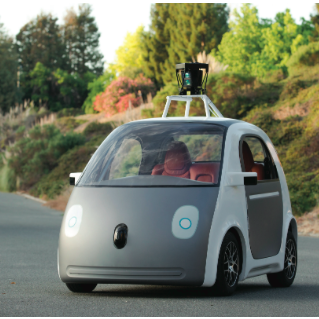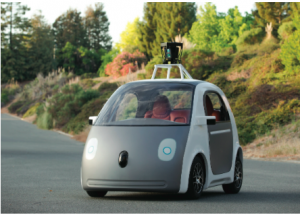
Self-driving cars will soon be rolling to a road near you.
Things have been a little grim around campus lately, so here’s a fun thought to kick off 2015: by the time Lorde turns 30, not only will you be able to use your phone to summon a self-driving pod to take you wherever your heart desires, but you will be so accustomed to it by that point that you will likely be more weirded out by the fact that Lorde is 30.
A few weeks ago, Google rolled out its first in-house line of self-driving vehicles. While the odd looking little cars may not invoke awe at first glance—they toddle along at a top speed of 40 km/ hour and bear a striking resemblance to the sort of wide-eyed Pokémon you might see hanging from a 7-year-old girl’s backpack—they may very well take over the world within the next decade.
These adorable little Herbie wannabes benefit from years of Google’s prototype testing on real-world roads—each new unit hits the pavement with 700,000 miles worth of driving experience programmed into it. They can navigate traffic stops, avoid debris in the middle of the road, and even use their advanced navigation systems to detect people and animals concealed behind roadside foliage.
Google and its resourceful little pod aren’t the only players in the self-driving market either. For those with higher-end tastes, the big names in the auto industry are hard at work on their own autonomous luxury vehicles. This week, Audi’s self-driving A-7 prototype will make the 550-mile trip from San Francisco to the Consumer Electronics Show in Las Vegas, Nevada. Mercedes Benz has already unveiled their own autonomous prototype at this event— it is a sleek, LED illuminated beast that looks like it rolled out of a cyberpunk fantasy, and has a roomy interior filled with touch screens and swivel seats, so that passengers can turn around and face each other if they want a more social experience.
Whatever the timeframe— optimists claim that we are three years away from an initial commercial release and ten years away from mainstream acceptance—these vehicles and their successors are going to spark an absolute revolution in transportation.
Self-driving cars promise huge advantages in terms of public health and safety—they are unaffected by fatigue, alcohol, or drugs, unable to experience road rage, and unwilling to ignore the rules of the road as many human drivers do when they think they won’t be caught. There are over 33,000 deaths per year in the US alone caused by negligent drivers, the largest single cause of death for those under age 35. Insurance experts have predicted that self-driving cars could reduce this number by a factor of 10.
Autonomous vehicles will also act as major sources of independence for people living with medical conditions that prevent them from driving. The ability to travel where and when one wants, independent of outside assistance, has the potential to improve the lives of millions of people who currently lack control over their own transportation options.
Many have speculated that businesses fielding large fleets of self-driving vehicles could find great success if they were to provide customers with membership based access as an alternative to car ownership. Such a system would allow the average customer full access to all the benefits of having both a car and a personal driver—door to door travel in bad weather, never needing to worry about finding a parking spot, and 24 hour access to transportation, regardless of drunkenness/ fatigue/car troubles—without the huge initial investment required to purchase a vehicle, the physical space needed to store a vehicle, or the day-to-day stresses of vehicle maintenance.
We can obviously already enjoy most of these benefits by calling taxis, but the cost to do so on a regular basis is prohibitive.
By signing customers up to long term guaranteed contracts and by eliminating the costs of employing human drivers, taxi companies could drastically lower the price of the average ride. (The CEO of Uber has already openly declared that his company will have no choice but to convert to this model when the technology reaches maturity, drawing the ire of more than a few of his flesh-and-blood contractors.)
At a low enough price point, such a service could become an invaluable resource for future generations of university students. Aside from the obvious convenience benefits, our demographic faces disproportionately high risks from fatal car collisions and dangerous, late night walks home. Cheap, convenient transportation options could go a long to improving this unfortunate current reality.
Widespread adoption could be environmentally friendly as well. A fleet of electric cars would offer massive efficiency improvements over the current system, which requires the factory production of millions of cars that end up spending the vast majority of their time parked in driveways unused. It would also help phase out also the use of older, less efficient vehicles, which are continually purchased and repaired by those who cannot afford the initial investment required for newer vehicles.
As with most new technological advances that promise such a disruptive shift, a sizable portion of the population may be reluctant to embrace autonomous vehicles. (And some public opinion polls have suggested this.)
We humans are creatures of convenience though. As self-driving vehicles become more ubiquitous and sophisticated, they will add more free hours to our days, eliminate the frustrations of parking spot hunting and trudging through bad weather, and perhaps even relieve us of the burden of maintaining expensive vehicles. Like cell phones, online shopping, and the internet itself, even those who are initially skeptical will likely be seduced as autonomous vehicles become the new norm.







